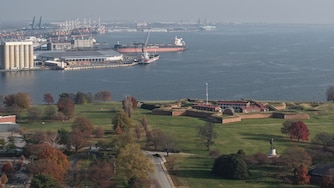In Baltimore’s latest effort to curb drug overdoses, the Maryland Transit Administration and city government are making naloxone available in Metro subway stations, officials announced Monday.
Each of the rail line’s 15 stops will have multiple boxes of the overdose-reversing drug positioned around the station by Friday. Each box contains multiple doses of naloxone nasal spray, personal protective equipment and a screen that displays an instructional video for administering the drug in both English and Spanish. The screens remain charged by connecting to the station’s power source.
Naloxone, also often referred to as Narcan, temporarily reverses the effects of opioids and can help restore an individual’s breathing. It can be lifesaving when administered in time to someone experiencing an overdose from fentanyl or other opioids.
“Today marks another milestone in our work to end this crisis here and across our city because every overdose is preventable,” said Baltimore Mayor Brandon Scott.
He was joined by members of the Baltimore City Council and other officials at the subway stop underneath Penn North, the neighborhood roiled by multiple mass overdose events this summer and fall that led to dozens of hospitalizations.
“In this neighborhood we see the gravity of the overdose crisis front and center, but we also see the power of community, the power of residents who continue to show up for one another,” Scott said.

Baltimore’s fatal overdose rate in recent years has surpassed that of any other large city in the country, an investigation by The Banner and The New York Times found, and has disproportionately impacted older Black men.
The naloxone boxes are coming out of the city’s opioid restitution fund, established after the city’s landmark lawsuits against multiple manufacturers of the addictive painkillers.
The initiative is part of the city’s strategic plan to fight overdoses by removing barriers to lifesaving services, said Sara Whaley, Baltimore’s director of overdose response.
“These partnerships reflect the simple truth that public transit does not exist outside of the environment and the community that we serve,” MTA Administrator Holly Arnold said. “When our community faces a crisis, we feel it too, and we want to be part of the solution.”
Arnold said that MTA will make optional training for administering naloxone available to staff, and the agency is looking into how it can expand the initiative to place boxes at light rail and bus stops.
The city also is working with local businesses and libraries to further expand access, said Tiffinee Scott, president of the Maryland Peer Advisory Council, a nonprofit focused on addiction recovery.
“This is in honor of all the lives that have been lost,” she said.



Comments
Welcome to The Banner's subscriber-only commenting community. Please review our community guidelines.